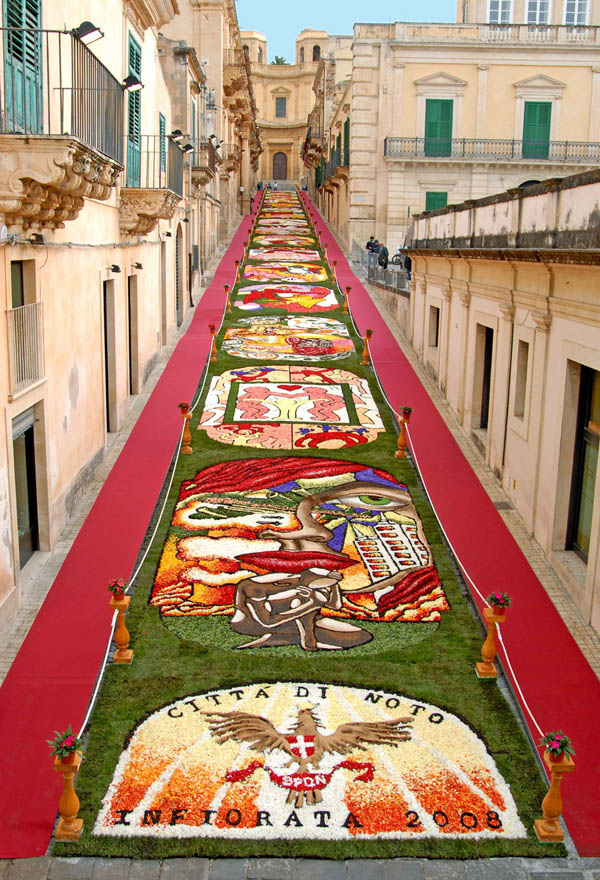Noto is known as the Pearl of Baroque, a small beautiful city just 15 minutes by car from Syracuse, 35 minutes by train or 50 minutes by bus. All connections leave from the stations located 50 meters from the hostel.
Neas, the Ancient Noto, is believed to have been founded by Sican populations, at the time of the fall of Troy. Falling into the hands of the Syracuse conquerors, the town absorbed Hellenic customs and rites, and was raised to the rank of a "gymnasium". Under the Roman domination, as a federate city, in the imperial epoch it was declared a Latin 'municipium', a singular condition which brought considerable privileges to the town, such as the possibility of being able to govern itself with its own laws. Conquered by the Arabs, who made it a highly armed stronghold. It took the present name and was the capital of one of three "valleys" when Sicily was divided by Arabs.
The history of Noto has been determined not so much by men as by nature: in 1693 it was destroyed by the earthquake which struck the south-western part of Sicily. Conceived as a big theatre without wings, as a lively and flowing town, Noto returned to life, sumptuous and superb, on the side of the Meti hill. The architectural vicissitudes of the new town were dominated by three architects, Rosario Gagliardi, Vincenzo Sinatra and Paolo Labisi, who succeeded in developing an amazing masterpiece showing architectural unity. These were three different personalities which, though living and working in the province, transmitted to the town an original mark which goes beyond the rigid Baroque idiom, being enriched with Renaissance, pseudo-Spanish and neo-classical elements and giving life to a fanciful and dreamy style.
The Triumphal arch, along the main path, marks the beginning of the town. Surmounted by three symbolic sculptures - a tower with battlements (power), a dog (fidelity) and a pelican (sacrifice) - the monument was built during a visit in Noto of Ferdinand II of Borbone, who inaugurated it in 1838. The royal gate was built in the typical golden calcareous stone used in the previous century to build churches and buildings in town.
The church of San Francesco all'Immacolata rises at the top of an imposing flight of steps at the right of the main path. It was built, together with the annexed convent, in 1704-45. The church has a single nave, according to the Franciscan custom. The walls are white and decorated with rococo style stuccoes. The Santa Chiara Church, made by Gagliardi, is a fine Baroque expression and was built in 1785. The interior, small and oval, is decorated with stuccoes and putti.
The Santissimo Salvatore monastery is the biggest building in town, built in 1710-91 on a rectangular area of 11,000 square metres. On the first floor flat twin pillars frame the big windows, whose rich decoration is reminiscent of the Portuguese plateresque style.Then follows a protruding wing which acts as a key in the construction conception; it rises like a tower over buildings and cupolas, and leaves no doubt about the superiority of this monastery compared to other orders.
This impression is emphasized by the rich stone decoration and the railings in wrought iron. The Santissimo Salvatore Church, built at the end of the eighteenth century, rises in a huge square. Its particular feature lies in the traces, in the façade, of the transition from Baroque to Classicism.The Cathedral, which stands at the top of a monumental staircase, was begun just a few months after the earthquake, but was only completed in 1770. The façade, devoid of ornaments, incorporates Baroque motifs and classical elements.
The three naves of the church are divided by high pillars with double pilasters. In the chapel at the back of the right nave the silver Ark of the patron saint of the town, San Corrado, is kept. Opposite the cathedral there is Palazzo Ducezio, which houses the Town Hall. Designed by the architect Sinatra, the palace was built in 1746-1830 with a single floor. A hundred years ago a second floor was built, this second floor has damaged the original neo-classical look. Of interest, inside, is the representation room, rich in gilding and stuccoes. Not far away there is Palazzo Villadorata, which looks out on Via Nicolaci, a narrow side street. The broad façade is characterized by protruding balconies in wrought iron held up by all sorts of ledges, with human and animal figures amid volutes and arabesques, the most extreme manifestations of Noto Baroque. Built in 1731, the building, which, for a long time, was the residence of the princes of Villadorata, was recently largely purchased by the town council. It contains ninety rooms, and in the ceilings there are eighteenth-century frescoes. In May in Via Nicolaci there is a traditional flower procession.
The street of Via Nicolaci is closed off by the Montevergine Church, attributed to architect Sinatra. Outside it is concave in shape, closed off between two lateral towers; inside there is only one nave, along which there are Corinthian columns. The Crocifisso Church is the second one in the town after the cathedral. It stands in the upper part of Noto, in Piazza Mazzini. Designed by Gagliardi (1715), it is the richest church talking about works of art. Inside there are two, column-bearing lions from the Romanesque epoch, recovered from the ruins of the Crocifisso church in the old town; there is also the white marble statue of the Madonna della Neve made in 1471 by Francesco Laurana.
Only 8 kms from Noto is the ancient settlement of Noto Antica (Ancient Noto) also known as Alveria, magic place where the remains of about 3000 years of hisotory still survive, from the palaeolitic tombs up to 1693, when the town was completely destroyed by the earthquake and then rebuilt where it is now.
